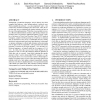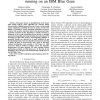302 search results - page 19 / 61 » Sequential circuits for program analysis |
SIGSOFT
2007
ACM
14 years 8 months ago
2007
ACM
Asynchronous systems components are hard to write, hard to reason about, and (not coincidentally) hard to mechanically verify. In order to achieve high performance, asynchronous c...
DAC
2009
ACM
14 years 8 months ago
2009
ACM
Traditionally, synchronous languages, such as Esterel, have been compiled into hardware, where timing analysis is relatively easy. When compiled into software ? e.g., into sequent...
SC
2005
ACM
14 years 1 months ago
2005
ACM
The memory consistency model in parallel programming controls the order in which operations performed by one thread may be observed by another. Language designers have been reluct...
ETFA
2008
IEEE
14 years 2 months ago
2008
IEEE
Programmable Logic Controllers (PLCs) play a significant role in the control of production systems and Sequential Function Chart (SFC) is one of the main programming languages. Th...
IPPS
2010
IEEE
13 years 5 months ago
2010
IEEE
This paper focuses on parallelization of the classic static timing analysis (STA) algorithm for verifying timing characteristics of digital integrated circuits. Given ever-increasi...


